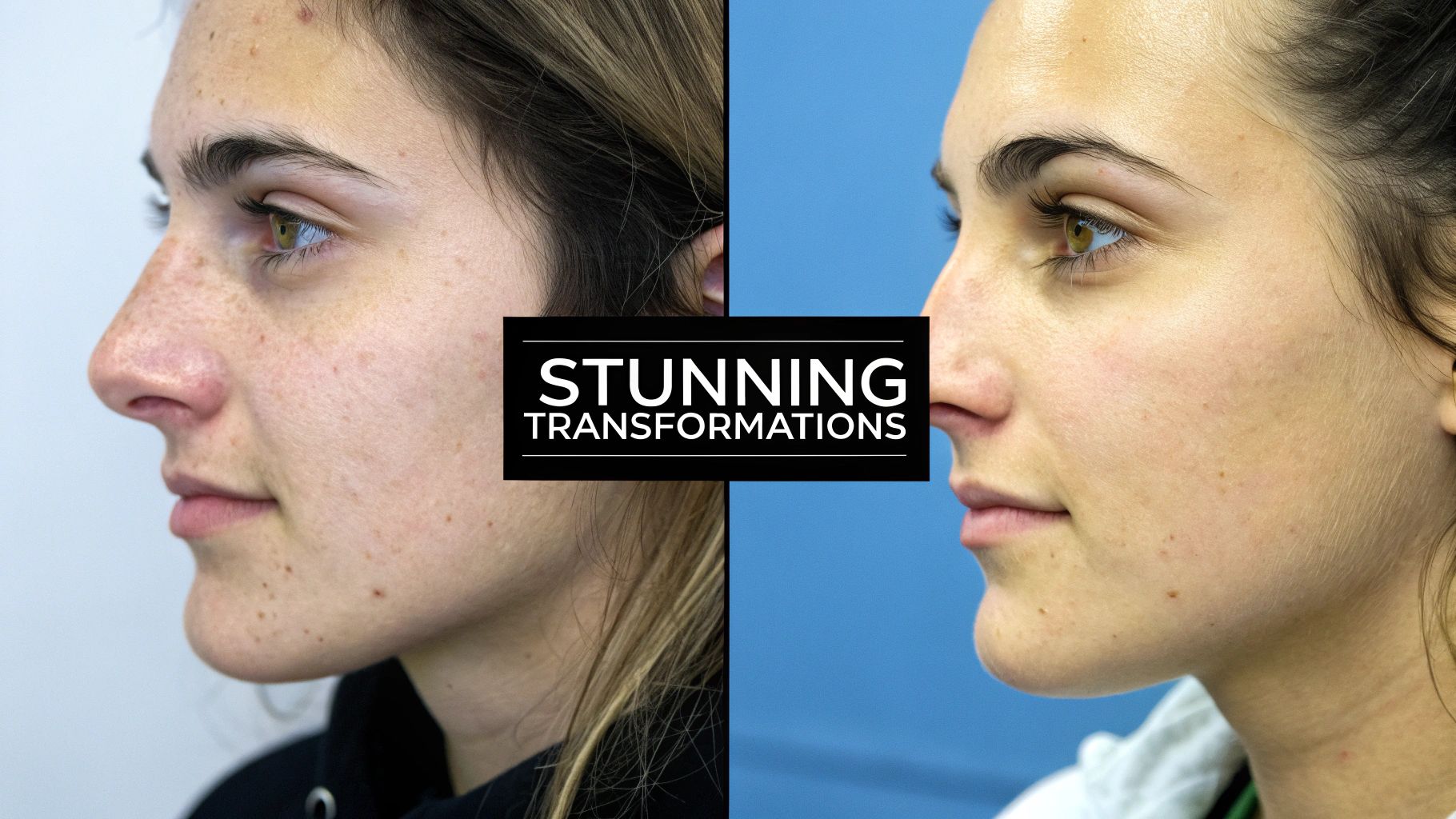
October 19, 2025
Rhinoplasty Before and After | See Stunning Transformations
Discover real rhinoplasty before and after photos, learn what to expect, and see final results. Your guide to natural, beautiful changes.
Oct 19, 2025

A truly great rhinoplasty before and after photo isn’t just about the physical difference. It’s about achieving a natural-looking, balanced nose that complements your unique facial features, and in many cases, helps you breathe easier. The ultimate goal is a harmonious result that looks like it was always meant to be there—the final chapter of a meticulous surgical process and a patient healing journey.
Thinking about a nose job means getting familiar with the entire process, from that first sit-down with your surgeon to seeing your final, confident result. It's a journey that demands patience. The "after" photo you're picturing in your head doesn't just appear overnight; it's a gradual refinement that takes time to fully emerge. To really appreciate how the transformation unfolds, you need a clear roadmap of what to expect and when.
This visual timeline breaks down the key healing milestones, showing how results evolve from the first week to the one-year mark.
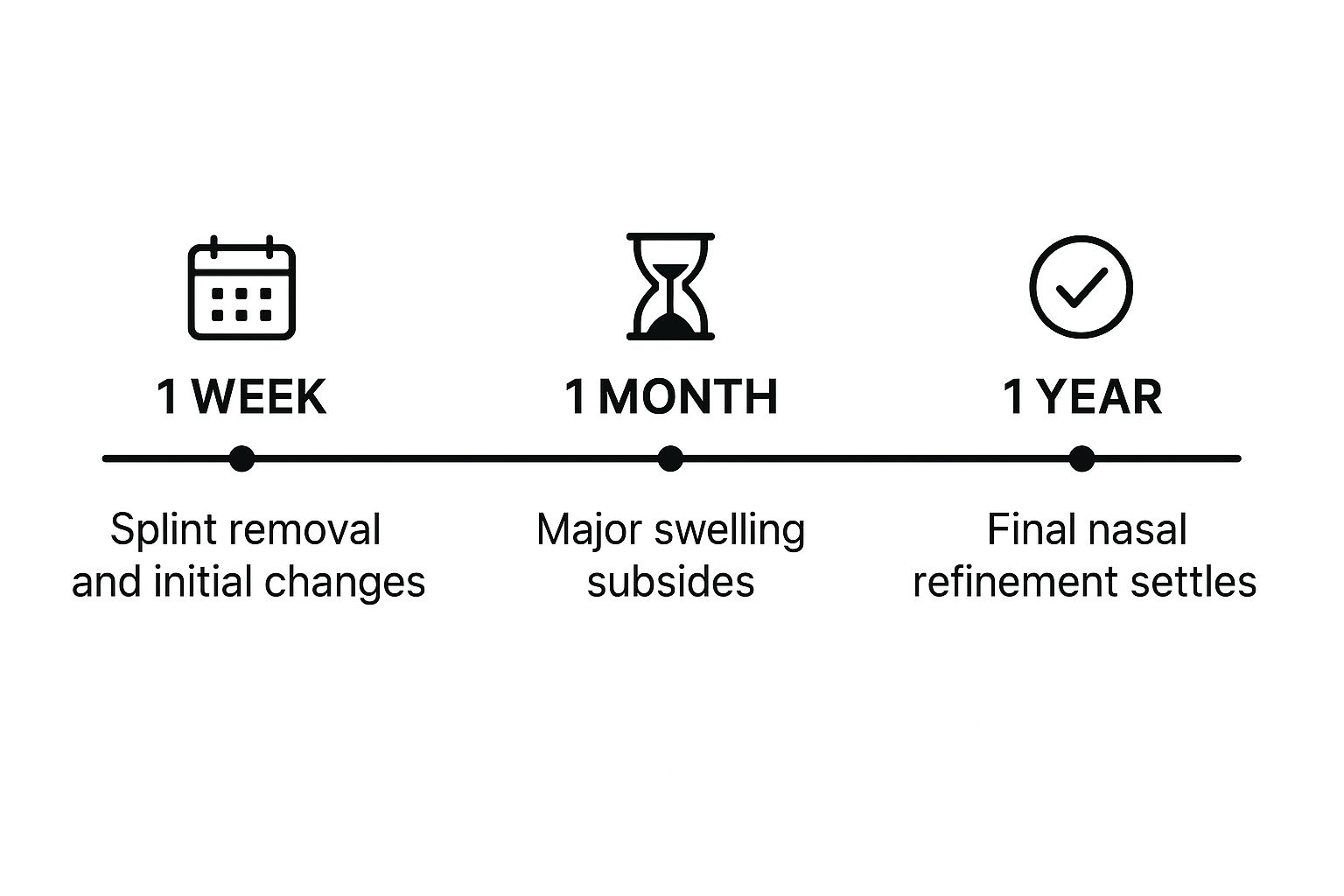
As the graphic shows, you'll see the biggest changes right at the beginning, but the final, subtle definition is a process that can take up to a year as the last traces of swelling fade away.
To give you an even clearer picture, here’s a breakdown of what you can expect to see at each key stage of your recovery.
This timeline really underscores the importance of patience. The nose you see at one month is not the nose you'll have at one year.
The decision to get a nose job is deeply personal. For some, it’s about correcting a dorsal hump or refining a bulbous tip. For others, it’s about finally being able to breathe properly. Whatever the reason, the objective is always the same: a result that fits your face. It’s not about chasing a generic "perfect" nose, but about creating one that brings your features into beautiful balance.
This pursuit of facial harmony is a big reason why rhinoplasty remains so popular. According to the International Society of Aesthetic Plastic Surgery (ISAPS), surgeons performed nearly 1.1 million nose reshaping procedures worldwide in 2023. That’s a staggering 21.6% increase from the year before, contributing to a broader trend where all facial procedures saw a 19.6% jump. You can dive deeper into these figures by exploring the global surgery trends on the ISAPS website.
Getting through recovery is much easier when you know what’s coming, both in the mirror and in your head. The journey really happens in a few key phases:
The most successful rhinoplasty before and after outcomes are those where the nose no longer draws attention. Instead, it blends seamlessly with your other features, allowing your eyes and smile to become the focal points.
To really appreciate the incredible transformations you see in rhinoplasty before and after photos, it helps to peek behind the curtain at the surgical artistry involved. Every nose job is a delicate dance between science and aesthetics, where the surgeon chooses specific tools and approaches to create the look you've envisioned. The very first decision they'll make is how to access the underlying bone and cartilage of your nose.
Think of it like a mechanic working on a sophisticated car engine. One might pop the entire hood for a wide-open, unrestricted view of every component. Another might prefer to work through smaller, specialized openings to keep the car's exterior completely untouched. This is the core difference between the two main rhinoplasty approaches.
The open rhinoplasty approach is just like lifting the hood of that car. Your surgeon makes a tiny incision across the columella—that little strip of skin between your nostrils. This allows them to gently lift the skin, giving them a direct, crystal-clear view of the nasal framework.
This total visibility is a huge advantage for complex cases requiring major reshaping, intricate tip work, or the placement of structural grafts to add support.
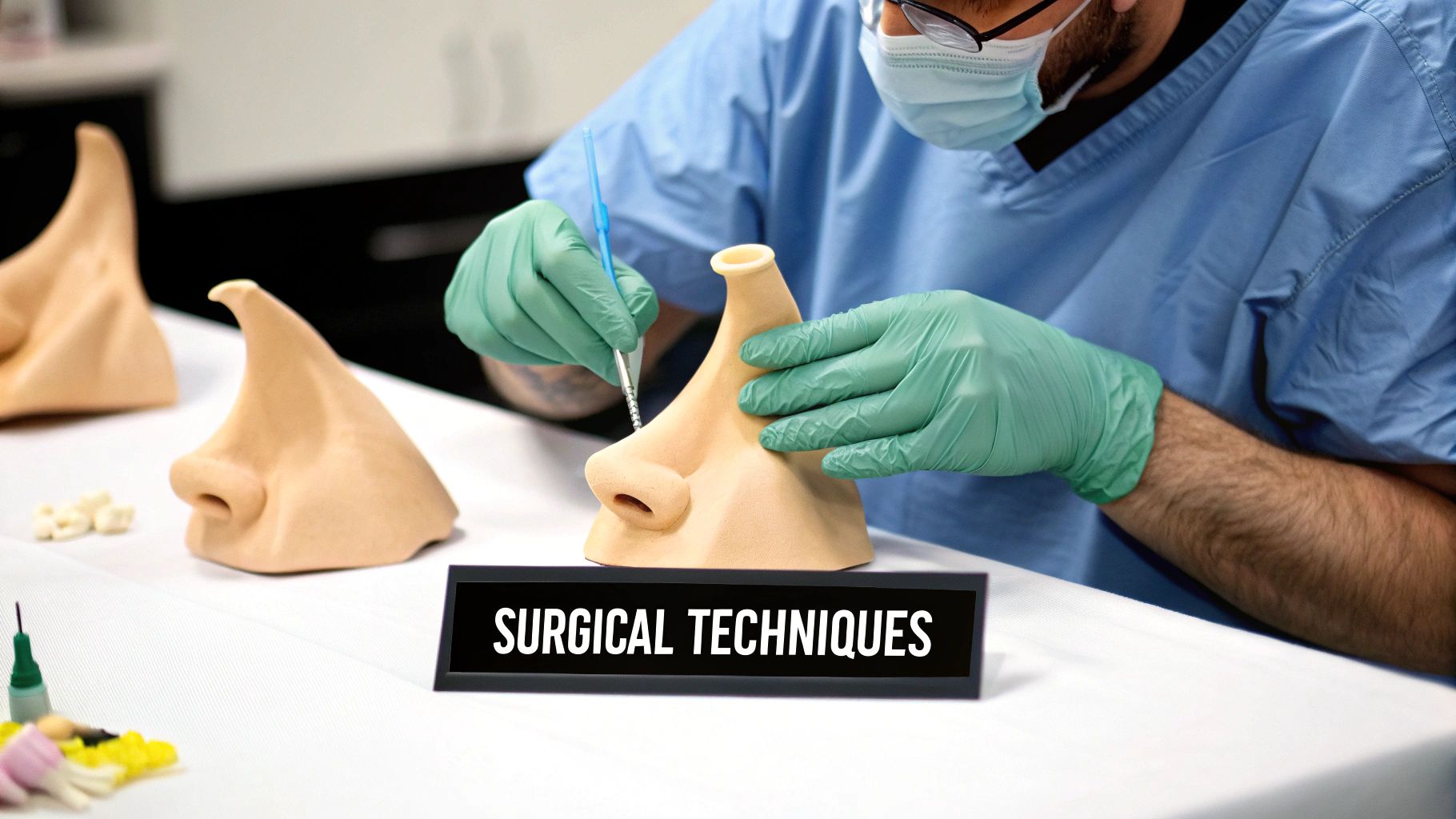
On the flip side, closed rhinoplasty is the "specialized openings" method. Here, all the incisions are hidden inside the nostrils, so there's no visible external scar. While it's a less invasive route, it means the surgeon is working through narrower channels with a more limited view. It's an excellent choice for patients who only need more straightforward adjustments, like smoothing out a bump on the bridge.
The choice between open and closed isn't about one being "better" than the other. It's about what’s best for your specific anatomy and your aesthetic goals. A truly skilled surgeon has mastered both, allowing them to deliver exceptional, personalized results every time.
From a technical standpoint, the open technique is incredibly popular because of the direct access it provides. It accounted for 51.3% of all rhinoplasty procedures in 2022 and continues to grow faster than other methods. You can dive deeper into these rhinoplasty market trends if you're curious.
Once the approach is decided, the specific goals of your surgery will dictate the exact techniques used. Rhinoplasty is anything but a one-size-fits-all procedure; it’s a highly customized operation designed to achieve a very particular outcome. Most of these goals fall into a few main categories.
1. Reduction Rhinoplasty
This is probably what most people think of when they hear "nose job." It’s all about reducing the overall size of the nose or refining specific features that seem too prominent.
2. Augmentation Rhinoplasty
Sometimes, the goal isn't to take away, but to build up. This is common for patients wanting to raise the bridge of their nose or add strength and projection to a weak or drooping tip. To do this, surgeons use cartilage grafts, which are usually taken from the patient's own septum, ear, or sometimes even a rib. This technique is surprisingly common, holding the largest market share at 18.3% in 2022, which just goes to show how important building structure and definition can be.
3. Functional Rhinoplasty
This type of surgery is less about looks and more about improving your breathing. The most common culprit is a deviated septum—the wall of cartilage dividing your two nasal passages is crooked. A septoplasty is the procedure to straighten it, and it's often done at the same time as a cosmetic rhinoplasty to open up the airways and make breathing easier.
Getting familiar with this terminology is incredibly empowering. It means you can walk into your consultation and have a much more meaningful and confident conversation with your surgeon. You'll be able to clearly explain what you want and, just as importantly, understand exactly how they plan to achieve the beautiful, natural-looking "after" you're hoping for.
Getting through the surgery is just chapter one of your rhinoplasty story. The next part of the journey—the healing process—is where the magic really happens, as your post-op nose gradually settles into its final, beautiful shape. Knowing what to expect week by week makes the whole experience feel less like a medical procedure and more like a predictable, manageable path.
I like to tell my patients to think of recovery like developing an old-fashioned photograph. At first, the image is blurry and undefined. But over time, the details sharpen, the lines become clear, and a crisp, final picture emerges. Your nose goes through a very similar process of refinement.
The first couple of days are all about rest and keeping comfortable. You'll likely feel groggy and congested when you wake up from surgery. Your nose will be protected by a splint and may have internal packing, so you'll need to breathe through your mouth.
Your main job here is to keep your head propped up, even while you sleep, which is a huge help in keeping swelling to a minimum. Most people describe feeling a sense of pressure or a dull headache, not sharp pain, which is easily managed with the medication we provide.
This is when the most dramatic healing takes place. You'll see significant swelling and bruising, which usually hits its peak around day three and can spread out to your cheeks and under your eyes. Don't worry—this is a totally normal part of the process.
The highlight of this week is getting your splint removed, usually between day five and seven. This is the very first time you’ll see your new nose! It's critical to remember that what you see isn't the final result; it will still be quite swollen. Even so, you’ll be able to see the new, underlying structure your surgeon created.
Patient Experience: The moment that splint comes off can be a real mix of emotions—excitement, relief, and often a little surprise. Because of the swelling, the nose might look wider and the tip more upturned than you expected. Just trust the process. This is a temporary phase before things start to settle and refine.
During this time, the most obvious signs that you've had surgery start to fade away. The bruising typically clears up, and a lot of that initial swelling goes down. By the end of the second week, most patients feel confident enough to head back to work or social events, often without anyone guessing they’ve had a procedure.
You still need to be careful, though. We’ll ask you to steer clear of strenuous exercise, heavy lifting, or anything that puts your nose at risk of a bump. Light walks are great for promoting good circulation. For a deeper dive, you might find our guide on essential recovery tips after plastic surgery useful.
This is when you really start to see the true shape of your nose come into focus. By the three-month mark, about 90% of the swelling is gone. The bridge of your nose will look much more defined, and the whole structure appears more settled and natural.
While you'll have a fantastic idea of the final outcome, a little bit of subtle swelling will hang around, especially at the tip. The nasal tip is always the last area to fully heal because the skin is thicker and the cartilage framework is more complex.
Patience is your best friend during this final stretch. Between six and twelve months, that last bit of residual swelling will slowly but surely disappear. The skin completely drapes over the new bone and cartilage structure, revealing all the delicate, precise contours of your final result.
This is the moment your "after" photo truly comes to life. The nasal tip gains its final definition, and your entire nose settles into a perfect, harmonious balance with the rest of your facial features. For some people with thicker skin, this final refinement can sometimes take up to 18 months.
Key Recovery Milestones:
Understanding this timeline helps you set realistic expectations and appreciate each stage of healing as one more step toward the beautiful, lasting result you’ve been waiting for.
Let’s be honest, words can only do so much. The best way to truly grasp what’s possible with rhinoplasty is to see the results for yourself. Looking at high-quality rhinoplasty before and after photos is where the abstract ideas of surgery become a tangible reality. It's where you can really appreciate the artistry and precision that goes into sculpting a nose that fits a patient's face perfectly.
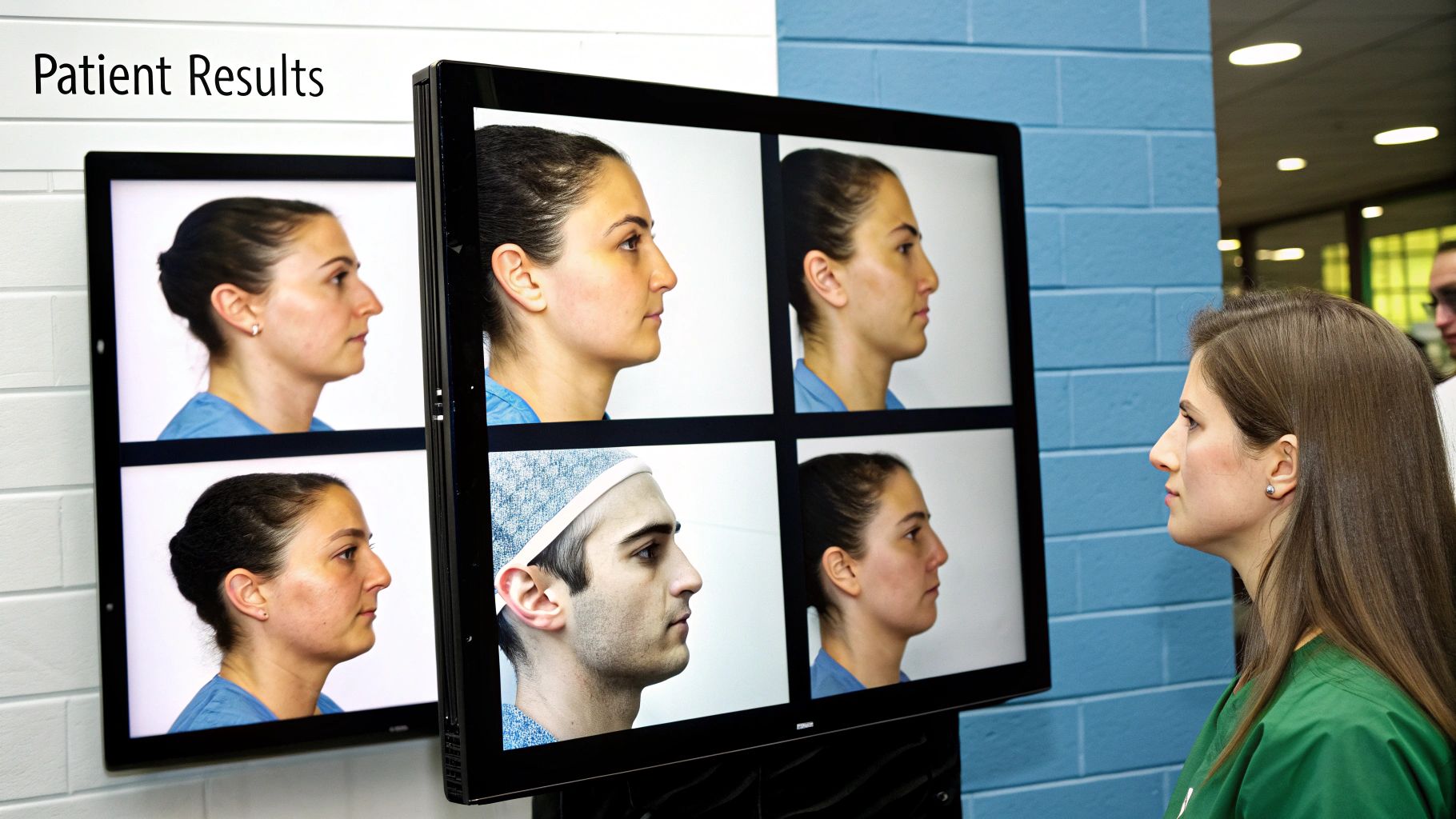
Browsing through a gallery of a surgeon's work does more than just show you what they can do; it helps you calibrate your own expectations. You get to see how different goals look on different people, which is a crucial part of your research. This visual library helps you find a surgeon whose aesthetic sense lines up with your own.
When you’re looking at these photos, try to see them through a critical eye. Don't just glance. Think of it like studying a piece of art—you want to notice the subtleties and the overall composition.
Here are a few things I always tell my patients to look for:
A good surgeon’s gallery is often organized by the patient's primary concern. This makes it so much easier for you to find examples that feel relevant to your own situation.
The gold standard for a successful outcome is a nose that looks completely natural—one that an observer would never guess has been surgically enhanced. It should simply look like the nose the patient was always meant to have.
This organized approach lets you zero in on specific examples of common goals. For instance, you can focus on cases that showcase the exact kind of changes you're hoping for. To see a wide variety of these transformations, feel free to explore our complete collection in the Cape Cod Plastic Surgery photo galleries.
Let's walk through a common scenario. A patient comes to me bothered by a prominent bump on the bridge of their nose. They feel it’s the first thing people notice and that it throws their whole face off-balance. The goal is straightforward: a smooth, straight profile.
In their "before" photos, the dorsal hump would be obvious from the side. In the "after" photos, taken a year or so later, you'd see a beautifully straight bridge. From the front, the nose would look more refined but still recognizably theirs, preserving their unique character.
Another goal I hear all the time is tip refinement. A patient might feel their nasal tip is too wide, round, or just lacks definition. They’re looking for a more elegant tip that's in proportion with the rest of their features.
The "before" shots would show a softer, less-defined tip. The "after" images would reveal a much more sculpted, refined point, which we achieve by carefully reshaping the cartilage underneath. It's a subtle change, but it makes a huge difference in the overall aesthetic without ever looking fake. Each set of photos really does tell a story of personal transformation.
A great rhinoplasty before and after gallery shows you the destination, but it rarely shows you the journey. Behind every one of those photos is a real person with a unique story—a reason they wanted a change, the patience they needed during recovery, and the emotional shift that came with seeing the final result. That's where the real magic of this procedure is.
A picture can show you a straighter bridge or a more refined tip, but it can't convey the feeling of taking a deep, easy breath for the first time in a decade. It can't show you the simple joy of not flinching when a friend pulls out a camera for a group shot. It’s these personal wins, big and small, that truly complete the picture.
Take the story of a patient—we'll call him Mark—a lifelong athlete who always felt held back by his breathing. For years, he just assumed his poor stamina was his body's natural limit. His "before" photo showed a crooked nose, sure, but the real problem was inside: a severely deviated septum that was choking off his airflow.
His decision to have a rhinoplasty was mostly about function. He was certainly pleased with a straighter, more balanced nose, but the real game-changing moment came a few weeks after surgery. He was out for a light jog and suddenly realized he could breathe deeply and fully through his nose. He’d never been able to do that before.
"I honestly just thought I was out of shape. The surgery didn't just change how my nose looked; it completely changed my relationship with fitness. It felt like I unlocked a new level of physical freedom I never knew was missing."
Mark's "after" photo is aesthetically excellent, but his story is really about renewed energy and performance. It's a perfect example of how, for many people, rhinoplasty is as much about feeling better as it is about looking better.
Now, let's think about Sarah, a young professional who had always been self-conscious about the prominent bump on her nose. It was something she felt made her profile look harsh, and she’d developed all these little habits to hide it, like tilting her head in meetings or avoiding side-profile pictures.
Her reasons were aesthetic, but the change she felt was psychological. The recovery process itself was a lesson in patience, waiting for the swelling to go down and wondering what her nose would really look like.
Once everything settled after about a year, the change was both stunning and subtle. Her friends told her she looked great but couldn't quite put their finger on why. For Sarah, the best part was the quiet confidence she felt inside.
The emotional benefits she noticed were huge:
Sarah’s story shows how the right rhinoplasty can lift a heavy emotional weight. The physical change you see in her rhinoplasty before and after photos was just the key that unlocked a new layer of self-assurance that was there all along. These are the stories that give the images meaning, showing how aligning your appearance with your sense of self can improve every part of your life.
Getting a fantastic rhinoplasty before and after result is a true partnership between you and your surgeon. Their skill in the operating room is obviously critical, but what you do before and after the procedure is just as important. When you become an active, well-informed participant, you have a massive influence on the final look.
This journey really starts long before surgery day. The first step is getting very clear on what you're hoping for. Forget about finding a celebrity nose you want to copy; instead, focus on what you’d like to change about your own nose. Is it a dorsal hump on the bridge? Are the nostrils a bit too wide for your taste? Maybe the tip feels too droopy or undefined.

Walking into that first meeting prepared is the best way to make sure you and your surgeon are on the same page from the get-go. This isn't just a listening session for you; it's your chance to clearly communicate what you want.
Here’s a quick checklist to get you ready:
The real aim of the consultation is to build a shared vision. A good surgeon will often use imaging software to create a simulation of your potential result. This turns your words into a visual you can both look at and agree upon.
Let's be clear: choosing your surgeon is the single most important decision you'll make in this entire process. You absolutely want a board-certified plastic surgeon who specializes in rhinoplasty. This is a surgery of millimeters, and that level of focused expertise is non-negotiable.
When you're looking at different surgeons, their before-and-after gallery is your best friend. Don't just scan for "good" results; look for a consistent style that you actually like. Do their outcomes look natural? Balanced? Crucially, do they have lots of experience with noses like yours? A surgeon's portfolio is the clearest window into their artistic eye and technical ability.
After the surgery, the ball is back in your court. How you take care of yourself in the weeks and months that follow directly impacts your final result, especially when it comes to controlling swelling.
Here are a few proven tips for a smoother healing process:
Finally, always remember that great results are about facial harmony. Sometimes, creating that perfect profile isn't just about the nose. For some people, a subtle chin enhancement can make all the difference in creating a more balanced and harmonious look. You can learn more about how a chin augmentation can define the profile you want in our related guide. By taking these steps, you put yourself in the driver's seat to achieve the beautiful, natural outcome you’re hoping for.
Thinking about a nose job brings up a ton of questions. It's totally normal. Getting straight answers is the best way to feel good about your decision, so let's dive into some of the things patients ask us most often.
You'll see a big change the moment the cast comes off, usually about a week after surgery. But what you see then isn't the final product. Most of the major swelling goes down within the first month, giving you a really good idea of the new shape.
The trickiest part is the subtle swelling, especially at the tip of the nose where the skin is thickest. It can take a full year for that last little bit of puffiness to completely disappear and for the ultimate, refined shape to settle in. Patience really is a virtue during this process, and your final rhinoplasty before and after result is well worth the wait.
This is probably the biggest concern for most people, and for good reason! The whole point of a great rhinoplasty is to get a result that looks like you were born with it. A talented, board-certified plastic surgeon works to create harmony and balance with your other features, not an obviously "done" nose.
The best nose job is one nobody knows is a nose job. It should just fit your face so perfectly that your eyes and smile are what people notice first.
Achieving this comes down to two things: being crystal clear with your surgeon about what you want and picking a surgeon whose photo gallery is filled with the kind of subtle, beautiful results you're hoping for.
Most of our patients are surprised to find it's more about discomfort than actual pain. For the first few days, expect to feel stuffy and congested—almost like you have a really bad head cold. A dull headache is also pretty common.
Your surgeon will give you medication to keep you comfortable, and it works very well. Honestly, the most annoying part for most people is having to breathe through their mouth for a few days while the nose is packed or swollen.
At Cape Cod Plastic Surgery, Dr. Fater and his team are passionate about delivering personalized care and stunning, natural-looking results. If you're ready to talk about your goals, we'd love to help you achieve them. Schedule your consultation at https://ccplasticsurgery.com.

October 19, 2025
Discover real rhinoplasty before and after photos, learn what to expect, and see final results. Your guide to natural, beautiful changes.

October 18, 2025
Feeling overwhelmed? This guide simplifies how to choose a surgeon. Get expert tips on credentials, experience, and consultation to make a confident choice.
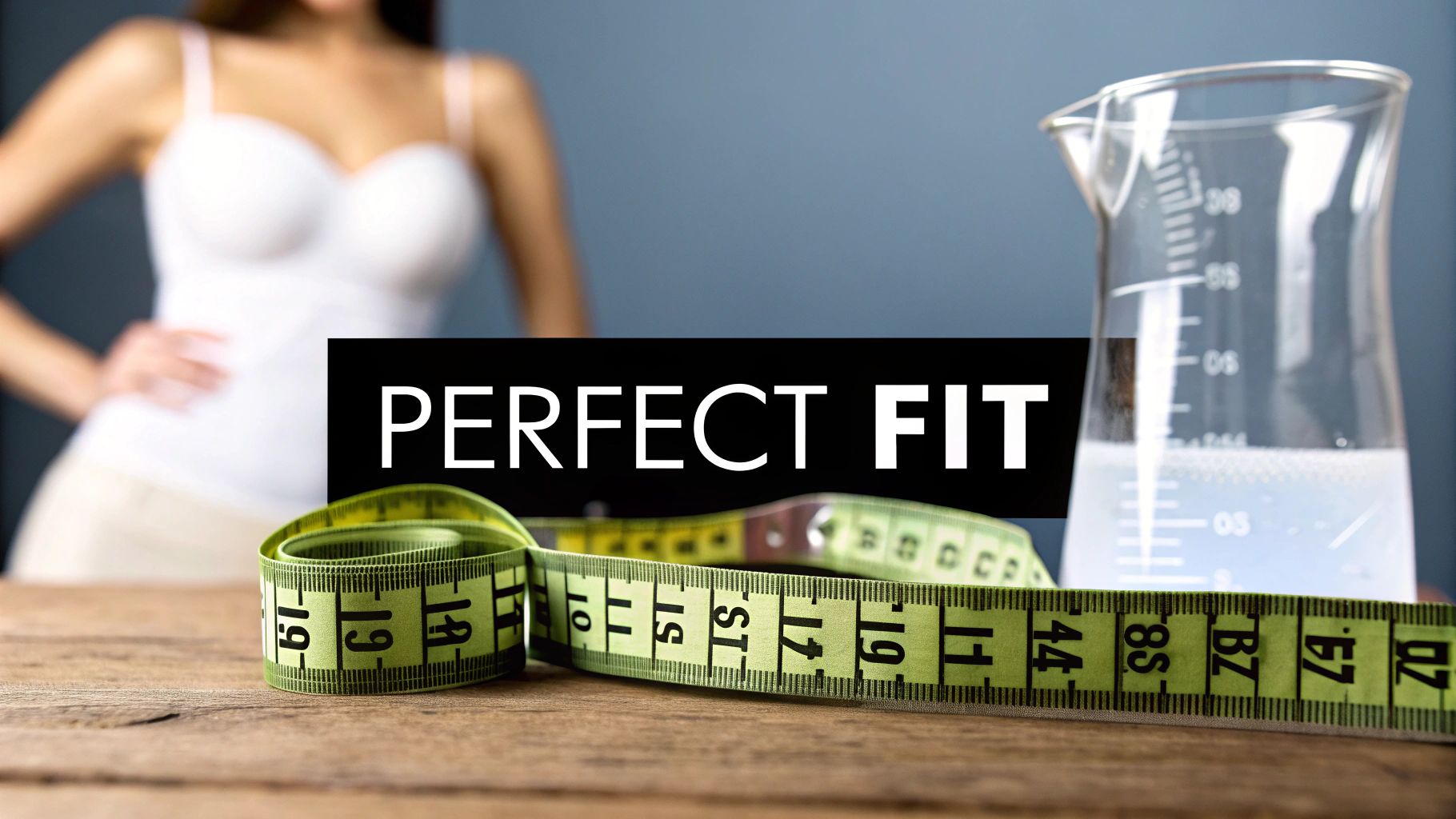
October 17, 2025
Discover our comprehensive breast implant size guide to choose the right CCs, profile, and shape. Make confident decisions for your ideal look!